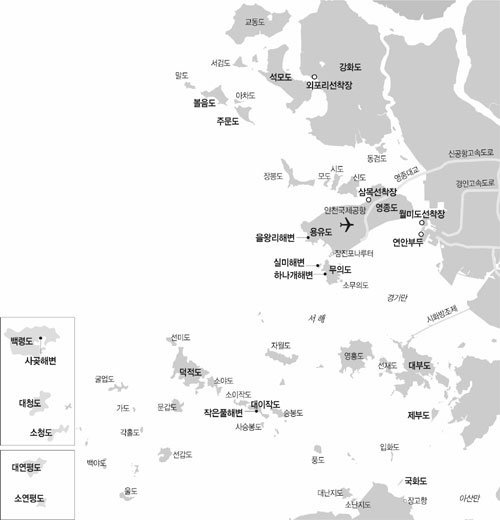The Islands Where Time Stops

The monsoon rains have passed and vacation season is in full swing. The east and south coasts are nice, but why not take a less expensive trip to nearby Incheon and the islands off the coast of Gyeonggi Province? The beaches on most of the islands offer shallow waters ideal for children, and during low tide the tidal flats offer a different kind of fun. For detailed information on lodging and transportation, you can consult the relevant local governments or their websites.
Ongjin-gun
Composed of 100 separate islands, Ongjin-gun boasts over 20 swimming beaches. In particular, the islands of Baekryeong, Daecheong, Socheong, Daeyeonpyeong, and Soyeonpyeongfamed as the West Coast Fivegenerally offer beaches covered with fine sand in addition to numerous other sights.
Baekryeong Island, which lies on the northernmost tip of the west coast, is home to Sagot Beach, a 3km stretch of fine sand. The Kongdol (meaning bean stone) Coast, strewn with pebbles the size of small beans, is also famous. Known to be the setting for the traditional novel Tale of Shim Cheong, this island has a pavilion dedicated to the eponymous fictional heroine (built in 1999) in its northern part. And its magnificent rock formations, like Dumujin and Sinseondae, inspire the viewer with awe.
On Daecheong Island, there are eight swimming beaches including those in Satan-dong and Jadu-ri, with water as clear as that found on the east coast. Sand dunes pepper the coastline, and fresh seafood caught in the Clean Water Zonelike all-natural skates, abalones, and sea cucumbersadd to the visitors enjoyment.
Yeonpyeong Island, from which you can see North Korea when the weather is clear, is renowned as the fishing grounds for blue crab. It offers the Guri-dong swimming beach, whose white sands are revealed by the retreating tide, as well as breathtaking coastal landscapes and numerous relics of the local culture.
Ganghwa-gun
Ganghwa-gun is home to a plethora of prehistoric relics and Joseon-era military bases. You can reach it by crossing the Ganghwa Grand Bridge and the Choji Grand Bridge. There are swimming beaches on Boleum Island (Jogaetgol) and Jumu Island (Daebinchang, Apjangsul, Dwitjangsul), about an hours boast ride away from Oepori Port.
The area is restricted to civilian traffic, so you will encounter several military checkpoints, but the lack of bustling tourists adds a solitary charm to the island. Local residents rent out rooms for lodging, but the beaches are ideal for camping out, thanks to shower facilities and the surrounding pine forest.
Jung-gu
You will find swimming beaches (Eulwang-ri, Wangsan) on Yeongjong Island (the location of the Incheon International Airport) and Yongyu Island. They are reachable by the Airport Expressway or by passenger ferry from Wolmi Island. The outdoor sets for the film Silmido and the TV drama Heavens Stairway are located on Mueui Island, where two swimming beaches (Silmi, Hanagae) are in operation. The island is roughly 15 minutes by boat from Jamjinpo Port on Yongyu Island.
Hwaseong-si, Gyeonggi Province
Although Gukhwa Island, in Wujeong-myeon, is part of Hwaseong-si, its closer if you take a boat from Janggo Port in Dangjin-gun, Chungnam Province. The ride takes anywhere from five to 10 minutes. Gukhwa Island boasts a beach where white sands mingle with pebbles and seashells that have been swept there by the waves over many years.
You can hop on a car to get to Jebu Island, in Seosin-myeon. A waterway extending 2.3km opens up for six hours twice a day during low tide. On the tidal flat, which stretches for over 500m on either side of the waterway, youll find a wealth of oysters and baby clams.
Kum-Chun Hwang kchwang@donga.com







